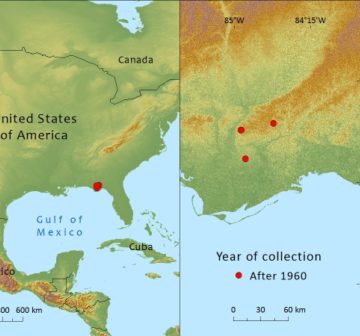Taxaceae
Taxus floridana
Endemic to a very small area in northern Florida, USA where historically the population was much depleted due to selective logging which has led to fragmentation and poor regeneration
References and further reading
- Kwit, C., Horvitz, C. & Platt, W. (2004). Conserving slow-growing, long-lived tree species: input from the demography of a rare understory conifer, Taxus floridana. Conservation Biology 18(2): 432–443.
- Kwit, C., Schwartz, M., Platt, W. & Geaghan, J. (1998). The distribution of tree species in steepheads of the Apalachicola River Bluffs, Florida. Journal of the Torrey Botanical Society 125(4): 309-318.
- Natureserve. (2009). NatureServe Explorer: Taxus floridana: An online encyclopedia of life [web application]. Version 7.1. (Accessed: July 28, 2010 ).
- Redmond, A. & Winn, A. (2010). Death and Taxus: Survival and recruitment in four populations of Florida yew (Taxus floridana). In: Florida Native Plant Society Native Plant Conference, Tallahassee, FL. May 19-22, 2010.
- Reinsmith, W.H. & Foreman, D. (1934). Report: exploring the Torreya trees in the Apalachicola Bluff County. Report to State Forester. Florida Forest Service.
- Sullivan, J. (1993). Taxus floridana. In: Fire Effects Information System, [Online]. Available at: http://www.fs.fed.us/database/feis/. (Accessed: 30 July).
- Mola, J.M., J.M. Varner, E.S. Jules & T. Spector (2014). Altered community flammability in Florida’s Apalachicola Ravines and implications for the persistence of the endangered conifer Torreya taxifolia. PLoS ONE 9(8):e103933. doi:10.1371/journal.pone.0103933.







